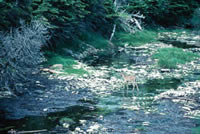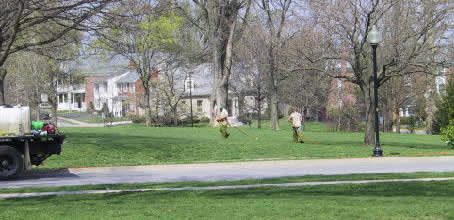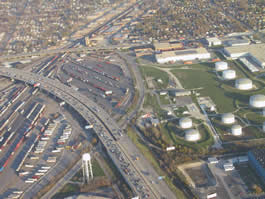|
What do a bay, a river, a major stream, and a tiny creek have in common—other than the fact that doing a belly flop in them gets progressively riskier? They're all parts of a watershed, which is essentially a geography-based drainage area. As housing developments, agricultural operations, and industries have expanded
 their footprints, the level of pollution in watersheds has increased.
their footprints, the level of pollution in watersheds has increased.
Today's article discusses some of the problems watersheds face and how they impact aquatic life and humans, and it outlines the role local groups play in protecting watersheds. The article was adapted, with permission, from Streamlines, a publication of River Network, a national nonprofit organization working to help people understand, protect and restore rivers and their watersheds.
~ ~ ~
Growth, Development, and Watershed Protection,
by River Network
Suburban Sprawl and Impact On Water
The vast majority of watershed groups in the United States rank the impacts of growth and development very high on their list of long-term concerns. A large and growing number rank it first on their list of immediate concerns. There is good reason for this. When growth is not well targeted, planned, and managed, watershed problems inevitably follow.
During typical development, the burden of silt and other pollutants that area streams carry is hundreds of times higher than normal. Silt chronically fouls water quality and smothers habitat. The effects usually last far longer than the development itself. This alone is enough to choke the life from most waters.
After typical development, the burden of oil (that runs off of streets, driveway and parking lots) and other pollutants (such as the lawn pesticides, chemical fertilizers, and pet feces) that area streams carry increases exponentially and for the long term.

Significant quantities of pesticides applied to suburban lawns and green spaces end up in local streams and rivers due to rainwater runoff.
Because of reduced surface permeability in the developed area, rainwater runoff during storms increases "high flows," and factors such as reduced groundwater recharge rates cause normal seasonal "low flows" to be much lower. As flows dwindle, less water is available to support stream-dependent life. Additionally, the concentrations of pollutants rise further as flow levels drop, adding to the impairment of fish and wildlife habitat. The lower amount of rainwater seeping back into the water table to recharge local groundwater supplies also decreases available drinking water supplies.
Unnaturally high peak flows destabilize stream channels, contribute to streamside vegetation loss and erosion, and further degrade habitat. "Flashier" high flows cause increased frequency and severity of flooding, prompting efforts to "control" rivers and streams with dikes, dams and concrete channels. Before long, rivers, streams, wetlands and lakes are irreparably harmed.
It is possible in many cases to reduce the impact of existing development, and wherever possible, we should. But there is simply no substitute for getting development right in the first place—for targeting it carefully, planning it thoughtfully, and managing it well to minimize its impact.
Watershed Protection Groups
Is anyone doing anything about these problems? The good news is, in many areas watershed groups are working these issues and they play a very important role in securing better growth planning and management. Several factors are working in their favor, including the fact that the public consistently ranks water quality and the effects of growth and development on quality of life very high on its list of concerns. Through education and advocacy, watershed groups are able show the public how these issues are connected, both in terms of problems and solutions.
Strategies and techniques for planning and managing growth and development have progressed a great deal over the past decade. Watershed groups are now playing
 a large and increasing role in establishing, testing, refining, promoting and implementing these new approaches.
a large and increasing role in establishing, testing, refining, promoting and implementing these new approaches.
Under the Clean Water Act and other laws, states have a responsibility to ensure that healthy waters are protected. Allowing growth to continue in the same old ways ensures that streams and rivers will not be protected. Whether state officials realize it or not—and most don't—they already have all the authority they need to work with local governments to manage growth in ways that protect water. One role that watershed groups play is to convince the public that their elected officials can and must take such actions—and that those who don't should be held accountable.
The rapidly growing numbers and strength of watershed groups have created tremendous potential for addressing growth and development issues. Because they are independent groups with local leadership and deep roots in their communities, and because the public strongly supports their cause, they often tip the scales in the local growth debate. They frequently achieve results in this arena, and others, that state and national groups cannot.
WRAP-UP
While this article focused on how watershed groups can advocate protection of our streams, rivers, and water supplies, there are many other aspects to the effort, including stream cleanup and water monitoring. Adults and kids across the nation are getting involved to help keep our local waterways clean. If you'd like to join a local watershed-protection group, check out River Network's state-by-state list of partners.
| Reprinted with permission from River Network, a national nonprofit organization working to help people understand, protect and restore rivers and their watersheds. Find them at www.rivernetwork.org. |
|
More articles and resources on....
Get Grinning Planet free via email
|


